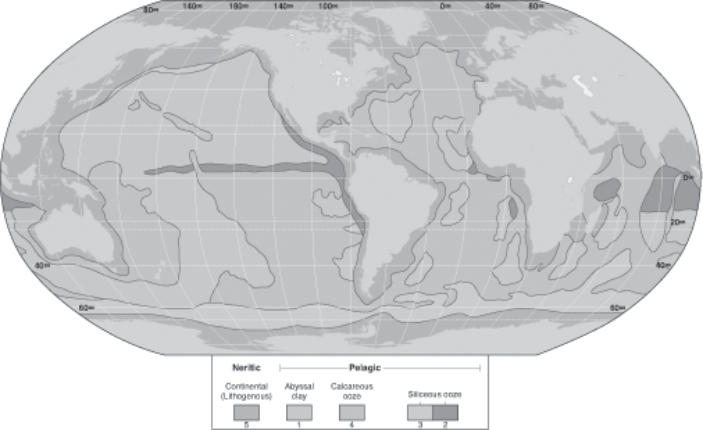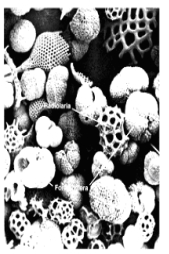A) coccolithophores
B) corals
C) foraminiferans
D) phosphorites
E) radiolarians
G) B) and C)
Correct Answer

verified
E
Correct Answer
verified
Multiple Choice
The major force bringing continental sediments to the open ocean is (are) :
A) glaciers.
B) neritic currents.
C) rivers.
D) turbidity currents.
E) wind.
G) A) and D)
Correct Answer

verified
Correct Answer
verified
True/False
Phosphate nodules are found on the continental shelf.
B) False
Correct Answer

verified
Correct Answer
verified
Multiple Choice
tektites
A) biogenous sediment
B) cosmogenous sediment
C) hydrogenous sediment
D) terrigenous sediment
F) A) and C)
Correct Answer

verified
Correct Answer
verified
Multiple Choice
Which of the following is not an important control on oceanic sediment accumulation?
A) degree of preservation
B) dilution
C) input from other sediment types
D) rate of deposition
E) All of the above factors are important.
G) B) and E)
Correct Answer

verified
E
Correct Answer
verified
Multiple Choice
Refer to the figure below illustrating the world-wide distribution of marine sediments.Different areas of ocean sediments are indicated by different numbers.Use these numbers to answer the questions below.
 -Biogenous sediments are indicated by the number(s) :
-Biogenous sediments are indicated by the number(s) :
A) 1.
B) 2 & 3.
C) 2 & 4.
D) 2,3,& 4.
E) 2,3,4,& 5.
G) A) and E)
Correct Answer

verified
Correct Answer
verified
Matching
Match the term or person with the appropriate phrase.You may use each answer once,more than once or not at all.
Correct Answer
Multiple Choice
A very important way to increase the settling rate of fine particles in the open ocean is via:
A) carbonate dissolution.
B) deposit feeders.
C) fecal pellets.
D) precipitation.
E) wind.
G) C) and E)
Correct Answer

verified
Correct Answer
verified
Multiple Choice
The element found in some sediments which suggest that a meteorite or asteroid impact occurred nearby is:
A) iridium.
B) manganese.
C) strontium.
D) uranium.
E) yttrium.
G) C) and E)
Correct Answer

verified
Correct Answer
verified
Multiple Choice
Manganese nodules are an example of a:
A) biogenous sediments.
B) cosmogenous sediments.
C) hydrogenous sediments.
D) terrigenous sediments.
E) volcagenic sediments.
G) All of the above
Correct Answer

verified
Correct Answer
verified
Multiple Choice
Calcium carbonate is most likely to dissolve in water with which characteristics?
A) low carbon dioxide and warm temperatures
B) lots of carbon dioxide and cold temperatures
C) lots of carbon dioxide and warm temperatures
D) low pressure and warm temperatures
E) low pressure and cold temperatures
G) B) and D)
Correct Answer

verified
Correct Answer
verified
Multiple Choice
Sediments produced by plants and animals in the sea called:
A) cosmogenous.
B) biogenous.
C) hydrogenous.
D) terriginous.
E) volcagenic.
G) A) and B)
Correct Answer

verified
Correct Answer
verified
True/False
Sediments derived from weathered rock and volcanic activity are called biogenous sediments.
B) False
Correct Answer

verified
False
Correct Answer
verified
Multiple Choice
stromatolites
A) biogenous sediment
B) cosmogenous sediment
C) hydrogenous sediment
D) terrigenous sediment
F) None of the above
Correct Answer

verified
Correct Answer
verified
True/False
The deposition of radiolarian oozes is affected by the carbonate compensation depth.
B) False
Correct Answer

verified
Correct Answer
verified
Multiple Choice
Sediments which are poorly sorted and made of a variety of minerals could have been deposited by:
A) a glacier.
B) a river delta.
C) turbidity currents.
D) a volcanic eruption.
E) the wind.
G) B) and D)
Correct Answer

verified
Correct Answer
verified
Multiple Choice
In general,polar neritic sediment has more:
A) clay than in temperate waters.
B) coral debris than in tropical waters.
C) rock and gravel than in tropical waters.
D) shell fragments than in temperate waters.
E) silt and sand than in tropical waters.
G) None of the above
Correct Answer

verified
Correct Answer
verified
Multiple Choice
silaceous ooze
A) biogenous sediment
B) cosmogenous sediment
C) hydrogenous sediment
D) terrigenous sediment
F) C) and D)
Correct Answer

verified
Correct Answer
verified
True/False
Calcareous shells will not accumulate on the ocean floor when the water depth exceeds about 4500 meters (around 15,000 feet).
B) False
Correct Answer

verified
Correct Answer
verified
Multiple Choice
The organisms in this photograph would most likely produce oceanic sediments that are:

A) calcareous.
B) cosmogenous.
C) lithogenous.
D) neritic.
E) siliceous.
G) A) and B)
Correct Answer

verified
Correct Answer
verified
Showing 1 - 20 of 49
Related Exams